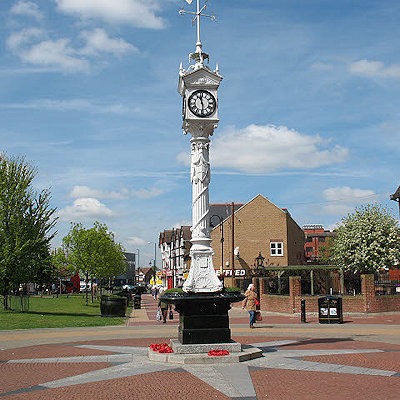
Like us on Facebook
PLACE NAMES


 
|
|
Mitcham
|

|
|
|
Mitcham is in the east of the London Borough of Merton and is bounded by the London Borough of Wandsworth, the London Borough of Croydon, the London Borough of Lambeth and the London Borough of Sutton. Mitcham is close to Wimbledon, Croydon, Streatham and Tooting. The River Wandle bounds the town to the southwest. The original village lies in the west, although expansion has pushed the eastern boundary the furthest. Mitcham Common takes up the greater part of the boundary and area to the south.
The toponym "Mitcham" is Old English in origin and means big settlement. Before the Romans and Saxons were present, there was a Celtic settlement in the area, with evidence of a hill fort in the Pollards Hill area. The discovery of Roman-era graves and a well on the site of the Mitcham gas works evince Roman settlement. The Saxon graveyard, located on the North bank of the Wandle is the largest discovered to date, and many of the finds therein are on display in the British Museum. Scholars such as Myres have suggested that Mitcham and other Thames Valley settlements were some of the first populated by the Anglo-Saxons. The area is a possible location for the Battle of Merton, 871, in which King Ethelred of Wessex was either mortally wounded or killed outright. The Church of England parish church of St Peter and St Paul dates from the Saxon era. Although it was mostly rebuilt in 1819-21, the current building retains the original Saxon tower. The Domesday Book of 1086 lists Mitcham as a small farming community, with 250 people living in two hamlets; Mitcham, an area known today as Upper Mitcham; and Whitford, today known as the Lower Green area.
The Domesday Book records Mitcham as Michelham. It was held partly by the Canons of Bayeux; partly by William, son of Ansculf and partly by Osbert. Its domesday assets were: 8 hides and 1 virgate. It had ½ mill worth £1, 3½ ploughs, 56 acres (23 ha) of meadow. It rendered £4 5s 4d.
During her reign Queen Elizabeth I made at least five visits to the area. John Donne and Sir Walter Raleigh also had residences here in this era. It was at this time that Mitcham became gentrified, as due to the abundance of lavender fields Mitcham became renowned for its soothing air. The air also led people to settle in the area during times of plague.
When industrialisation occurred, Mitcham quickly grew to become a town and most of the farms were swallowed up in the expansion. Remnants of this farming history today include: Mitcham Common itself; Arthur's Pond, sited on the corner of Watney's Road and Commonside East, and named for a local farmer; Alfred Mizen School (Now named Garden Primary), named after a local nursery man who was very charitable towards the burgeoning town; and the road New Barnes Avenue, which was named after the farm that stood on that site.
There were many lavender fields in Mitcham, and peppermint and lavender oils were also distilled. In 1749 two local physic gardeners, John Potter and William Moore, founded a company to make and market toiletries made from locally-grown herbs and flowers. Lavender features on Merton Council's coat of arms and the badge of the local football team, Tooting & Mitcham United F.C., as well as in the name of a local council ward, Lavender Field.
Mitcham was industrialised first along the banks of the Wandle, where snuff, copper, flour, iron and dye were all worked. Mitcham, along with nearby Merton Abbey, became the calico cloth printing centres of England by 1750. Asprey, suppliers of luxury goods made from various materials, was founded in Mitcham as a silk-printing business in 1781. William Morris opened a factory on the River Wandle at Merton Abbey. Merton Abbey Mills were the Liberty silk-printing works. It is now a craft village and its waterwheel has been preserved.
The activity along the Wandle led to the building of the Surrey Iron Railway, the World's first public railway, in 1803. The decline and failure of the railway in the 1840s also heralded a change in industry, as horticulture gradually gave way to manufacturing, with paint, varnish, linoleum and firework manufacturers moving into the area. The work provided and migratory patterns eventually resulted in a doubling of the population between the years 1900 and 1910.
Post war, the areas of Eastfields, Phipps Bridge and Pollards Hill were rebuilt to provide cheaper more affordable housing. The largest council housing project in Mitcham is Phipps Bridge estate. Further expansion of the housing estates in Eastfields, Phipps Bridge and Pollards Hill occurred after 1965. In Mitcham Cricket Green, the area lays reasonable, although not definitive, claim to having the world's oldest cricket ground in continual use, and the world's oldest club in Mitcham Cricket Club.[citation needed] The ground is also notable for having a road separate the pavilion from the pitch. Local folklore also claims Mitcham has the oldest fair in England, believing it to have been granted a charter by Queen Elizabeth I, although this claim has not been proven.
|
 Feel free to Email me any additions or corrections Feel free to Email me any additions or corrections
LINKS AVAILABLE TO YOUR SITE
| |





